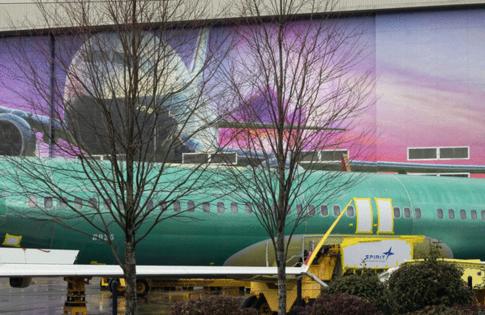After months of limits, FAA allows Boeing to increase Max production
Published in Business News
The Federal Aviation Administration will allow Boeing to increase production of its 737 Max, clearing a hurdle the regulator put in place after a nearly catastrophic panel blowout last year.
The FAA capped Boeing’s Max production at 38 planes per month after a door-sized panel flew off an Alaska Airlines 737 Max in January 2024, revealing production lapses in Boeing’s Renton, Washington, factory. On Friday, in a sign that the regulator believes the manufacturer has made improvements, the FAA said it would increase that cap to 42 planes per month.
“FAA safety inspectors conducted extensive reviews of Boeing’s production lines to ensure that this small production rate increase will be done safely,” the FAA said in a statement, adding that its “direct oversight” of Boeing will not change.
Boeing’s CEO Kelly Ortberg has told analysts the company hoped to increase its production rate, outlining a plan that would bump the monthly rate in increments of five, with a similar safety and quality review with the FAA before each step up. Ortberg said he expected roughly six months between each rate increase.
To help gauge how well Boeing’s production system is doing, and when it may lift the production cap, Boeing and the FAA have been tracking six metrics, including employee proficiency and supplier shortages.
Ortberg told analysts in September that Boeing continued to struggle with one metric, the number of hours spent reworking tasks on the aircraft. But, he continued, “we see that progressing well.”
In September, Ortberg said he expected Boeing would “pretty soon” sit down with the FAA for what it calls a capstone review, a look at the company’s entire supply chain and an indication that it was nearing a decision on raising the production cap.
A spokesperson for Boeing said Friday the company would work with its suppliers to “increase production in a disciplined manner.”
“We appreciate the work by our team, our suppliers and the FAA to ensure we are prepared to increase production with safety and quality at the forefront,” the spokesperson said.
Boeing maintained a slower rate of production for more than a year after the panel blowout. It reached a rate of 38 Max planes per month in May, the company said.
The blowout, and the FAA’s unprecedented restrictions, came while Boeing was still recovering from two fatal 737 Max crashes in 2018 and 2019. The production threshold stopped Boeing’s march to increase the flow of planes through its factory, preventing it from bringing in more cash.
In its most recent earnings release, Boeing reported a net loss of $612 million, or 92 cents per share, for the three months from April to June. During the same three months last year — when Boeing was still reeling from the panel blowout — it lost $1.4 billion, or $2.33 per share.
The FAA’s production cap also paused the company’s plans to open a fourth Max production line in Everett, Washington. Boeing now expects to use that line for its yet-to-be-certified Max 10 variant.
In September, the FAA signaled another vote of confidence in Boeing when it allowed the company to again self-certify the airworthiness of some 737 Max and 787 Dreamliner planes. The regulator revoked that authority after the fatal Max crashes.
Friday’s decision comes amid a government shutdown that has limited the scope of some federal tasks. The FAA said in a statement that “safety critical personnel, including inspectors at Boeing,” are continuing to work.
©2025 The Seattle Times. Visit seattletimes.com. Distributed by Tribune Content Agency, LLC.












Comments